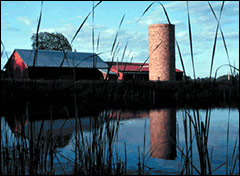wilderness
-
Roadless rule limited to 10 Western states, judge rules
A federal judge on Tuesday limited the scope of President Clinton’s popular “roadless rule” to federal lands in 10 Western states instead of the whole country, leaving some 13.6 million acres of roadless forests largely unprotected from road-building and other development. Tuesday’s ruling is a compromise between throwing the rule out and keeping protections in […]
-
Rights of humans, rights of nature
Two items I’ve been tracking while away for a blissful two weeks of vacation here on the Atlantic shore, one hopeful, one awful: Hopeful: Ecuador is poised to grant rights to nature and ecosystems in a referendum this month. The idea originated in the U.S. — in Pennsylvania — as some small towns fought odious […]
-
15 green books you can actually read at the beach
Green books that are fun to read? What a novel idea. So maybe you’ll finally have a chance to catch up on some reading this summer. But so many of those books about the environment seem kind of … well, homework-y. What’s a vacationing enviro to do? Turn to Grist for advice, of course! Here […]
-
Forests and fires foster fearsome feedbacks
Previously, I looked at why the permafrost won't be perma for long. Then I looked at whether the potential destruction of the tundra represents the point of no return for the climate, necessitating that we keep atmospheric concentrations of carbon dioxide below 450 ppm or else risk going to 800 ppm to 1,000 ppm. Here I examine two local amplifying feedbacks that further threaten the permafrost: forests and fires.
Reduced snow cover and albedo (reflectivity) in the summertime Arctic landscape, caused by global warming, has added local atmospheric heating ($ub. req'd) "similar in magnitude to the regional heating expected over multiple decades from a doubling of atmospheric CO2." That same Science study warns "Continuation of current trends in shrub and tree expansion could further amplify this atmospheric heating 2-7 times."
-
Why the Everglades is burning, and how we sucked it dry
It’s hard to believe, now that it’s been overrun by 7 million residents and 7 jillion strip malls, but southern Florida was once America’s last frontier. As late as 1880, the census recorded just 257 residents in a county covering most of the region — because most of the region was a watery wilderness called […]
-
E.O. Wilson calls for kids to be set free outside, scripted activities be damned
Renowned biologist and naturalist E.O. Wilson regaled the crowd at last week’s Aspen Environment Forum with his wit and wisdom during an on-stage interview. A choice segment: The worst thing you can do to a child, in my opinion, is take them on a hike through a botanical garden where there are the names of […]
-
Chertoff lies, wildlife dies
Homeland Security Secretary Michael Chertoff announced yesterday that he's going to just waive the Endangered Species Act, the Toxic Waste Disposal Act, the National Environmental Policy Act, and the Migratory Bird Treaty Act (among many others) in order to plough ahead with building a wall along the Arizona-Mexico border in the San Pedro Riparian National Conservation Area.
He repeated his rationale that the wall could be good for the environment because migrants leave behind trash:
But there are also environmental reasons to stop illegal crossings in the SPRNCA. Illegal entrants leave trash and high concentrations of human waste, which impact wildlife, vegetation and water quality in the habitat. Wildfires caused by campfires have significantly damaged the soil, vegetation, and cultural sites, not to mention threatened human safety.
As anyone who's spent any time along the border (or, really, anywhere on the planet) can attest, this statement is a complete lie. A little pile of trash in the wilderness might be unsightly, but it has nowhere near the effect of a giant, honking, double layered concrete wall. (Which, um, is a little more unsightly, if that's the standard we're going by.)
Since when is a wall a solution to trash anyway? I think usually, Mr. Chertoff, the way people clean up trash is by picking it up. What jaguars and bobcats and Sonoran pronghorn antelope and ocelots need is not a trash-free wilderness, but a wilderness that doesn't cut them off from the breeding populations on the other side of the border. Increased Bush administration border activity and the climate crisis have already reduced populations of the endangered Sonoran Pronghorn Antelope from 500 to below 25.
-
Why environmental groups have been slow to fight the border wall
The bobcat turned, looked at me, and jumped into the mesquite brush. It was the first day of a three-day visit to South Texas, and I was exploring the Santa Ana National Wildlife Refuge along the Rio Grande River. Seeing the bobcat was a treat for me — but the kind of treat that could […]
-
What was it like 430 million years ago
The earth, as a living organism, leaves behind breadcrumbs from millenia of development. And beautiful breadcrumbs they are.
Check out Frans Lanting's project and fall in love all over again. From Stewart Brand's account of a presentation as a part of the Long Now series:

